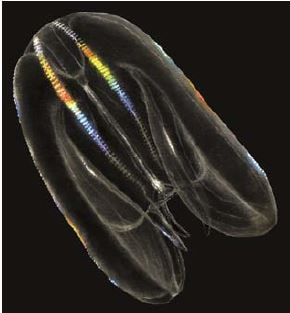2. JELLYFISH BLOOMS IN THE MEDITERRANEAN AND BLACK SEA
2.1. The Black Sea and Mnemiopsis, a paradigmatic example
The ctenophore Mnemiopsis leidyi (Fig. 11) was first detected in the Black Sea in 1982 (Peredalov, 1983). This species is typical of the Atlantic coast of the USA, and was probably brought to the Black Sea as a clandestine passenger in the ballast waters of US oil tankers. The Black Sea has several native gelatinous plankters but, evidently, they coevolved with their prey and predators and they never caused serious problems. Mnemiopsis, instead, built huge populations and put the Black Sea fisheries on their knees, depleting the nekton by feeding on fish eggs and larvae (direct predation) and on their crustacean prey (competition), as reported, for instance, by Kydeis (1994) and Shiganova (1997). For the first time, it was undeniable that fisheries can be severely affected by gelatinous plankton (besides the clogging of fishing nets during episodic blooms).

Figure 11. Mnemiopsis leydi (art by A. Gennari).
The problem was almost solved by another ctenophore invader, Beroe ovata, presumably coming from the same Atlantic ecosystem where Mnemiopsis thrives (Finenko et al., 2000). Beroe feeds on Mnemiopsis and its arrival in the Black Sea mitigated the impact of the alien, just as it probably does in the original ecosystem of both species (Shiganova et al., 2004). For the first time, with the case of Mnemiopsis, it became clear that the predation and competition of gelatinous zooplankton can have an overwhelming impact on fish populations and, hence, on fisheries.
Meanwhile, in other parts of the world, and especially along the USA coasts, plankton ecologists had been showing that gelatinous plankters do feed on fish eggs and larvae and proposed estimates for their impact on fish populations (e.g. Purcell, 1985). But these claims apparently passed unnoticed by fisheries ecologists, who continued to envisage man as the sole cause of decrease of fish populations.
Between the extreme of zero impact allotted to gelatinous plankton by traditional fisheries ecologists and the total impact allotted to Mnemiopsis there is probably some intermediate measure.